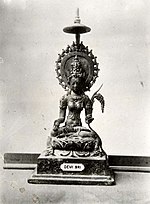This article needs additional citations for verification. (March 2010) |
| This article is a part of the series on |
| Indonesian mythology and folklore |
|---|
 |
|
|
In Malaysian, Bruneian and Indonesian folklore, Bunian people or Orang bunian (Indonesian pronunciation: [o.raŋ bu.ni.an]) are supernatural beings said to be invisible to most humans, except those with "spiritual sight". While the term is often translated as "elves", it literally translates to "hidden people" or "whistling people". Orang bunian are described as beautiful, dressed in ancient Southeast Asian style, and nearly identical to humans in appearance. Some mythological accounts describe the lack of a philtrum. Modern depictions of Orang bunian deviate from the traditional folklore by including elf-like features, pointed ears, high fantasy-influenced attire, or modern Minangkabau long coat clothing.[1]
Orang bunian are said to inhabit the deep forests or high mountains in Sumatra, Borneo & Malay Peninsula, far from human contact,[2] as well as near human communities, and are even said to share the same houses as human families.[3] According to legend, their social structure is similar to that of humans in the ancient Malay Peninsula, with families, clans, and royalty. As with other mythical beings in Indonesian folklore, Orang bunian often have supernatural powers,[4] and must be appeased with certain rituals and customs before humans are allowed to trespass areas which they inhabit.
Orang bunian are generally regarded as benevolent, befriending and assisting humans, particularly magicians (dukun or bomoh) and shamans (pawang).[5] They are said to be able to intermarry with humans and bear invisible children.[6] According to some tales, men had married Orang bunian women but later decided to leave the bunian community and return to the families they had left behind. However, after returning to human society, they found that many years had passed and everyone they once knew had died. These narratives have been compared to Urashima Taro and Rip Van Winkle.[7]
- ^ Hadler, Jeffrey (9 October 2008). Muslims and Matriarchs: Cultural Resilience in Indonesia Through Jihad and ... By Jeffrey Hadler. ISBN 9780801446979. Retrieved 2012-06-23.
- ^ Lost hiker mystery: Did ‘orang bunian’ kidnap Teo Kim Lean?
- ^ International transnational associations: Associations transnationales internationales, Volumes 50-51. 1998. Retrieved 2012-06-23.
- ^ Forth, Gregory (10 December 2008). Images of the Wildman in Southeast Asia: An Anthropological, Perspective By Gregory L. Forth. ISBN 9780203886243. Retrieved 2012-06-23.
- ^ Believe it or not, they’re out there
- ^ "Tales of the 'orang bunian' - Views - The Star Online". www.thestar.com.my.
- ^ Werner, Roland (1993). Transcultural healing: the whole human : healing systems under the influence of Abrahamic religions, eastern religions and beliefs, paganism, new religions, and mixed religious forms, Roland Werner, University of Malaya Press, 1993 - Health & Fitness - 430 pages. ISBN 9789679940480. Retrieved 2012-06-23.
